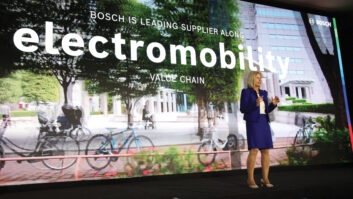NEW YORK — The vision has been laid out for more than a decade: a nationwide “smart grid” that connects every electric power source with every electric power-consuming device or appliance, allowing twoway communications between them — much like the Internet connects all our individual PCs and lets them communicate.
The fruition of such a smart grid will allow power to flow like data, automatically pumping more energy from sectors of the grid with low demand and high supply to sectors with high demand and low supply. It will regulate non-essential power use, allowing us to do our laundry or run our dishwasher when demand is low and therefore rates are lower, producing incremental savings. Multiply those incremental savings by hundreds of millions of users, and real energy conservation can yield hundreds of millions of dollars in savings to consumers and strengthen the country’s power grid.
The bad news: We are years away from that scenario. Compared with the growth of the Internet, the smart grid rollout hasn’t even reached the AOL vs. Compuserve stage yet. In other words, it is in its infancy.
But the technologies that are being woven together to form a nationwide grid can be utilized individually, and many bridge products — designed to help manage a household’s energy use, combat phantom power draw and charge devices more efficiently — have been reaching the market gradually over the last couple years.
Many of them, such as smart thermostats and lighting-control systems, are grounded in the custom-install market, but others are simple plug-and-play solutions that the average CE consumer may find appealing for their ease of use.
For instance, the Efergy remote-controlled four-socket kit allows a user to turn appliances and components on and off remotely.
The sockets are plugged into any normal AC outlet. Once a device is plugged into the socket, the power flow can be turned on and off via the included RF remote control, making it convenient to cut standby power without having to unplug the devices, especially with hard-to-reach outlets behind appliances or in cabinets.
Extra sockets and remote controls are available to extend the system.
8G Electronics has introduced a mobile charging device that doubles the charging capacity of any AC outlet and can lower a user’s electric bill.
The new USB Sock-It Plugin Outlet provides two USB ports and two AC plugs for simultaneous charging of devices. It features a 0.25-inch lip that fits neatly over any standard outlet.
It delivers 3 amps of shared power — equivalent to the power needed to charge two iPads simultaneously. Once a device is plugged in, the Sock-It measures how much power and current the battery needs, and only delivers that much, preventing battery overheating. If a second device is plugged in for charging, the second USB charger will give up the remaining power available. When the device’s battery is fully charged, the Sock-It senses it and automatically turns off, elimination phantom power draw. An LED light turns off when a device is completely charged.
The removable cover allows for permanent installation and it allows continued control of a plug-in lamp from a wall switch via a split-outlet selector. A switch on the back allows a user to designate one of the AC plugs to be controlled by a light switch, and it still has the USB DC power available for both of the USB smart chargers.
“The world relies on staying connected, and more and more people consume data than ever,” said David Novak, 8G’s marketing VP. “The Plugin Outlet stands to be our flagship product, and is designed to help the consumer convert their everyday electrical outlets into a USB charging solution … with Smart Technology added to boot.”
The USB Sock-It Plugin Outlet will retail for $24.99.
ThinkEco’s Modlet, which rolled out nationally to consumers last year, is a “smart” energy-use regulator that plugs into a standard electrical outlet. The Modlet, or “modern outlet,” monitors power draw in real time, second by second, and automatically cuts power to plugged-in electronics based on personalized schedules, so consumers can start paying for only the electricity they need.
Through Zigbee-based web software, consumers can adjust schedules through a simple slider interface to control electricity use and track cost savings. The same software can be used to control electronic devices wirelessly, from any web browser or Internet-connected mobile device.
The Modlet starter kit includes a two-socket Modlet, a USB receiver and free software download. Additional Modlets can be purchased to create an energy-saving network of connected electronic devices.
ThinkEco said the Modlet is designed for simple self-installation. Once the software is installed it guides the user through a step-by-step setup script. Any electronic device that is then plugged into the Modlet is smart-control enabled.
The Modlet’s software is driven by an intelligent engine that recommends ways for users to reduce their energy use and waste after monitoring their devices over a two-week baseline period. Users can convert these recommendations into actual savings with oneclick scheduling. Users can alternately manually set the Modlet’s schedule down to the minute, based on their own use schedule. The software continually recognizes usage patterns over time and suggests fine-tunings to save more power.
The Modlet software also comes with schedule templates for common applications, such as a “federal holiday plan” that lets users schedule their devices differently on holidays. Each Modlet also has a one-touch manual schedule override button.
The software also includes a savings tracker and downloadable data capability for more in-depth energy use analysis.
A social-networking interface allows a user to opt in to share power usage and savings with the Modlet community of users, set up competitions, and share information and tips on specific model devices.
Belkin’s Conserve Valet energy-saving USB charging station charges up to four devices at once and shuts off automatically when not in use. It replaces up to four charging bricks with one power cord to free up wall outlets and an integrated timer turns off after 4.5 hours of charging time to save energy.
The LEG3 Smart Strip is specifically designed to work with stereo devices such as receivers and preamplifiers which have a 12-volt control or trigger jacks.
The Smart Strip helps to cut down on power expenses by sensing the current in one outlet and then smartly switching on or off the rest of the outlets. Acting as the control outlet is an 1/8-inch mono connector (male).
The LEG3 Smart Strip will activate with an external voltage control signal that ranges from 4 to 24 volts. When a device that is attached to the connector is turned on, the strip will automatically turn on the switched outlets, which will then supply power to all the equipment plugged in.











